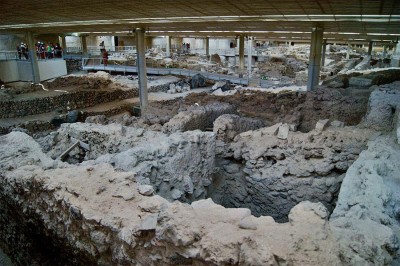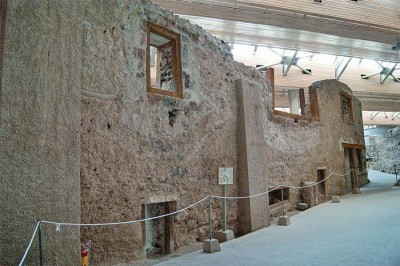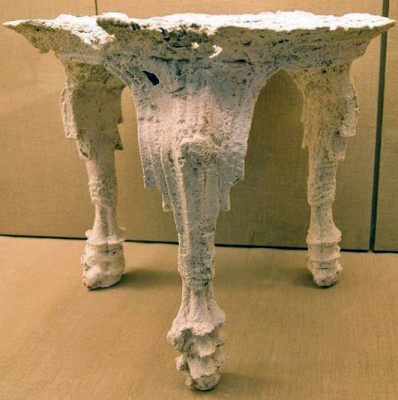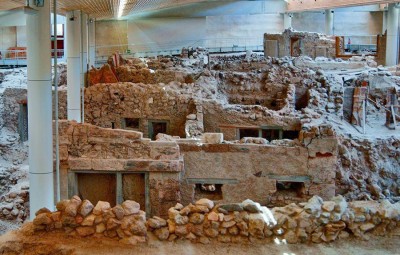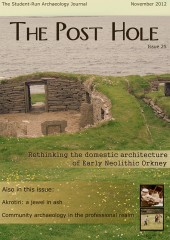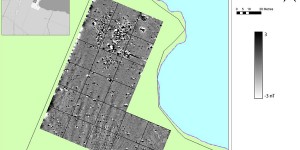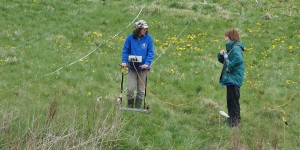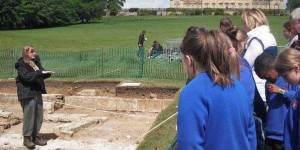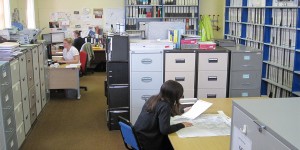It all began with an article by Spyridon Marinatos published in Antiquity in 1939, in which he proposed a new theory regarding the demise of the Minoan civilisation on Crete. Marinatos dismissed the then popular theory of invaders and focused on the various phases of destruction and rebuilding evident in the islands palaces (Marinatos 1939). He drew attention to their quick rebuilding after destruction, in the same style and without fortification, suggesting that the remaining cause of destruction could only have been natural (Marinatos 1939).
As Crete is located near the so-called Hellenic Trench, the island experiences intense seismic activity (Taymaz et al. 1990), which led both Sir Arthur Evans and Marinatos to conclude that this was the cause of the various destructive phases (Marinatos 1939).
Marinatos suggested that the final destruction of the Minoan civilisation might have been caused by an enormous eruption of the volcano on the nearby island of Thera, better known as Santorini (Marinatos 1939). Marinatos’s article was accompanied by a note from the editors suggesting that in order to prove his thesis, Marinatos needed additional evidence from excavation (Marinatos 1939).
Unfortunately, these excavations were not to take place for almost 30 years. Whilst investigating the island of Thera, Marinatos, with the help of locals, old maps and scarce documentation of earlier investigations was able to identity a particular area of interest (Doumas 1983). Excavations began in 1967; Marinatos soon realised that the excavations would be long-term and as a result suitable accommodation, laboratories and workshops were built near the site, and some of these buildings are still present although most of them have now been replaced with modern facilities.
To protect the site from erosion a roof was constructed (Figure 1), using Dexion pillars, chosen because the pillars are stable and flexible, and they can be placed as much as 12m (39ft) apart without any solid walls, making it easy to extend the roof in any direction. The pits dug for the pillars were treated as test pits; they were dug down to the natural ground level ensuring no archaeology would remain hidden underneath the pillars (Doumas 1983).
Plans for a replacement roof were made in the late 1990s and construction was almost complete when on the 23rd of September 2005 part of the new roof collapsed, injuring 6 tourists and killing another (Doumas 2005). The site closed down completely, and no tourists or even archaeologists were granted access (Doumas 2006). Signs were placed at the entrance that stated that the site was temporarily closed due to construction, and additional guards were hired to ensure that the site was ‘protected’(Doumas 2007). The closure of the site would last until the 11th of April 2012 (anon. 2012).
Excavation
Initially, tunnelling was attempted at the site; however, because much of the soil at the site is made up of volcanic mantle and debris, the dangers of collapse and the inability to record stratigraphy properly, led to this approach being abandoned in favour of single-context excavation (Doumas 1983).
No grid-square system was initially applied in the excavations; instead, Marinatos used triangulation methods based on well preserved walls, which unfortunately means that retrospective analysis of the excavation records can no longer accurately reconstruct the inter-relationships of some of the buildings (Doumas 1983). The use of a grid system was eventually introduced along with a permanent water sieving installation built in 1976; although it has since been concluded that dry sieving is perfectly adequate as well as being less time consuming (Doumas 1983).
As is the standard at most excavations today, every find had to be processed in a set of procedures. The objects were cleaned, restored if necessary and then catalogued, photographed and often also drawn. At the time of writing his book, Doumas reports that 10 buildings had been (partly) explored and 7 more are known to be within the roofed area at the time (1983).
Marinatos oversaw the excavations until his untimely death in 1974, after which excavations were halted for two years until Christos Doumas took over his position as site-director (Doumas 1983). For those travelling to the site, Marinatos has been buried on the ‘Akrotiri grounds’ and his grave can be visited.
The site
Akrotiri is a Minoan harbour town, buried in ash and pumice. However, the site is not just any town frozen in time... its multi-storey buildings and colourful frescos provide an extraordinary window into the Bronze Age of Thera and the Aegean.
The view when entering the modern structure built over the site is breath taking. To the front is the structure called Xeste 3 and ‘The house of Benches’, these are thought to have been public buildings. Other famous buildings are: ‘The House of the Ladies’, ‘The West House’ and ‘Xeste 4’. ‘The House of the Ladies’ is named after the frescos that were discovered inside the building, which are now on display in the Museum of Prehistoric Thera, in Fira. The West House (Figure 2), so-called because it is the most western building, houses one of the oldest known upstairs toilets. It is situated at a triangular square, has low rectangular windows on the ground floor and enormous windows on the second floor. Xeste 4 is famous because it is a three storey building.
The site has proven to be very rich in material culture, especially pottery and stone tools and vases. In addition, negative imprints of artefacts made of natural resources have been found, from which casts can be obtained (Figure 3). In this manner a few beds have been discovered as well as chairs and tables. Despite the excellent recovery of ‘domestic’ material, it wasn’t until the early 2000s that the first golden object was discovered (Baum 2004). No jewellery and few precious metals have been found (one exception being a bronze sword, now on display in the Museum of Prehistoric Thera).
Another notable absence at the site is human remains. It has been theorised that before the volcanic eruption that covered the town a series of earthquakes made the inhabitants flee to safer grounds (Doumas 1983; Gates 2011, 127–129). Excavation has found that the ruined buildings seem to have been ‘cleared out’. Assuming that a temporary camp was established between the earlier destruction and reconstruction of the town, it is possible that people returned to the town to remove any possible victims and valuables and neither people nor their possessions returned to the site following the eruption (Doumas 1983; Gates 2011, 127–129). However, no such temporary settlement has been found (Doumas 2008). The search for the harbour belonging to Akrotiri commenced at the beginning of this year (Flora 2012), reflecting that a lot of the town and activity there is yet to be found.
Workers
The site is occupied not just by archaeologists, but also by a large on-site conservation team, including fresco specialists. The first fragments of frescos were found in 1968 (Doumas 1983). Marinatos realised that specialised techniques were needed in order to conserve and reconstruct these frescos. Help was sought from Byzantine Fresco Restoration and removal experts were called in. The initial group developed a technique specific for the Akrotiri frescos and are now known as ‘Akrotiri wall painting experts’ (Doumas 1983). The experts note the location of the fragments, collect them and transfer them to the nearby workshop where they are cleaned and put back together like a giant jigsaw puzzle. The reconstructions are done in a vertical position with grid systems and maths, to calculate their position on the ground relative to where the fragments would have been on the wall (Doumas 1983). Although most of the frescos have been found as fragments on the floor, some have been recovered from the walls they were painted on. An elaborate process has been developed to safely remove these in order to conserve them. Due to the delicacy and haste involved in the restoration and conservation, the fresco laboratories have been built close to the site (Doumas 1983).
Another group of professionals working on the site are pottery experts. Although some of the pottery found is still in one piece and sometimes still within the pumice and ash, much is found in sherds. The sherds are recorded and moved to the workshop where they are examined, cleaned, reconstructed and conserved. In the workshops and laboratories samples of any remaining residues on them can be obtained and examined (Doumas 1983).
Marinatos’s theory
A lot of literature on the subject of the Minoan civilisation has been published since the discovery of Knossos in 1900, and most indicate different dates for its demise: 1400BC (Vermeule 1972), 1450BC (de Blios and van der Spek 2001), or 1500BC (Kehnscherper 1986). As indicated by Doumas, the 1450BC date is perhaps most commonly accepted (1983). Marinatos set out to provide evidence for his Theran Volcano eruption scenario and found Akrotiri, but what happened to his theory?
Since the beginning of the excavations there, samples have been taken for radiocarbon dating. These were tested by University Museum, Philadelphia, Pennsylvania, but unfortunately resulted in very different dates; 1100±190 BC and 2590±80 BC (Doumas 1983). By the time that Doumas wrote his book, tests had been conducted on ice cores resulting in a date of about 1500BC (1983). However, new radiocarbon tests executed in 2004 resulted in a date range of 1663 – 1599BC (Bronk Ramsey et al. 2004). Nowadays the newly revised and (widely, but not generally) accepted eruption date is 1628BC (Doumas 2008; Gates 2011).
When visiting the Museum of Prehistoric Thera an information board can be found indicating all the work of Marinatos. However, despite all the new information gathered from Akrotiri, it has not confirmed
Marinatos’ theory. Papers have been published regarding the cause of the demise as well as the date of the great eruption of the volcano; however the debate remains open (Warren 1990; Lasken 1992; Dunn 2002).
Opportunities
It has been estimated that only 5% of the town has so far been excavated (Figure 4). Many volunteers accepted to work on the site are Archaeology students. To get more information regarding the site or field work opportunities please contact the Society for the Promotion of Studies on Prehistoric Thera at akrotiri [at] otenet.gr.
The Society for the promotion of studies on Prehistoric Thera was founded in 2003, and annually publishes AΛΣ (ALS) – with updates regarding the work surrounding Akrotiri. These can be bought for €10.00 from the not-for-profit foundation.
The site itself is open on Tuesdays to Sundays from 8am to 5pm, and entrance for students is free.
Bibliography
- anon. (2012) 'Akrotiri reopens to the public'. Current World Archaeology. Available at: http://www.world-archaeology.com/news/akrotiri-reopens-to-the-public/ [Accessed November 2, 2012]
- Baum, M. (2004) 'The Golden Ibex of Santorini - A Convergence of Cultures & Technologies'. The Journal of Surgery. 2 (1). 61–62
- Bronk Ramsey, C., Manning, S.W. and Galimberti, M. (2004) 'Dating the volcanic eruption at Thera'. Radiocarbon. 46 (1). 325–344
- de Blios, L. & van der Spek, R.J. (2001) Een kennismaking met de oude wereld (6th Ed.) Bussum: uitgeverij Coutino
- Doumas, C. (2007) '40 Years'. AΛΣ (5). 7–45
- Doumas, C. (2008) The early history of the Aegean in the light of recent finds from Akrotiri, Thera. Athens: Society for the Promotion of Studies on Prehistoric Thera
- Doumas, C. (1983) Thera, Pompeii of the ancient Aegean, excavations at Akrotiri 1967 - 1979. London: Thames and Hudson
- Doumas, C. (2005) 'Work at Akrotiri in 2005'. AΛΣ. (3) 7 – 17
- Doumas, C. (2006) 'Work at Akrotiri in 2006'. AΛΣ. (4) 7–16
- Dunn, S. (2002) 'The Theran Eruption'. Journal of the Ancient Chronology Forum. 9. 22–31
- Flora, C. (2012) 'Santorini’s Prehistoric Akrotiri Harbor Studied'. Greek Reporter. Available at: http://greece.greekreporter.com/2012/10/30/santorinis-prehistoric-akroti... [Accessed November 2, 2012]
- Gates, C. (2011) Ancient Cities (2nd Ed.) London: Routledge
- Kehnscherper, G. (1986) Kreta Mykene Santorin (6th Ed.) Leipzig: Urania - Verlag
- Lasken, J.E. (1992) 'The radiocarbon evidence from Thera, an alternative interpretation'. Journal of the Ancient Chonology. 5. 68–76
- Marinatos, S. (1939) 'The Volcanic Destruction of Minoan Crete'. Antiquity. Available at: http://antiquity.ac.uk.ezproxy.york.ac.uk/ant/013/Ant0130425.htm [Accessed October 27, 2012]
- Taymaz, T., Jackson, J. & Westaway, R. (1990) 'Earthquake mechanisms in the Hellenic Trench near Crete'. Geophysical Journal International. 102 (3). 695–731
- Vermeule, E. (1972) Greece in the Bronze Age (5th Ed.) London: The University of Chicago Press
- Warren, P. (1990) 'The Minoan Civilisation of Crete and the Volcano of Thera'. Journal of the Ancient Chonology. 4. 29–39


